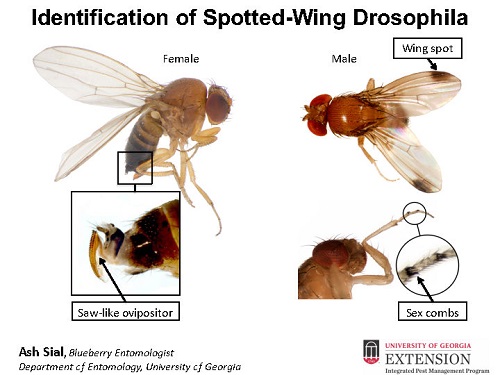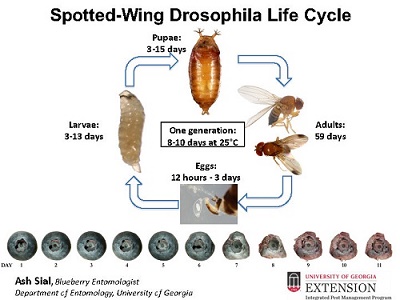
Looking for SWD- Spotted Wing Drosophila Identification and Control for Home Orchards in 2025? Scroll down this page and follow the links. And if you bring home some fruit or vegetables and want to can, freeze, make jam, salsa or pickles, see this page for simple, reliable, illustrated canning, freezing or preserving directions. There are plenty of other related resources, click on the resources dropdown above. If you are having a hard time finding canning lids, I've used these, and they're a great price & ship in 2 days.
If you have questions or feedback, please let me know! There are affiliate links on this page. Read our disclosure policy to learn more.
SWD- Spotted Wing Drosophila Identification and Control for Home Orchards
SWD- Spotted Wing Drosophila Identification and Control for Home Orchards
 Have you cut into a blueberry, raspberry or other fruit, only to be disgusted when you saw a tiny white "worm" inside? Odds are, you saw the larvae of
Spotted-wing drosophila (SWD), Drosophila suzukii (Matsumura) (Diptera: Drosophilidae). SWD is an invasive species of fruit fly that first appeared in
California in 2008, and spread rapidly across the United States. It was in Georgia by 2010.
Have you cut into a blueberry, raspberry or other fruit, only to be disgusted when you saw a tiny white "worm" inside? Odds are, you saw the larvae of
Spotted-wing drosophila (SWD), Drosophila suzukii (Matsumura) (Diptera: Drosophilidae). SWD is an invasive species of fruit fly that first appeared in
California in 2008, and spread rapidly across the United States. It was in Georgia by 2010.
SWD attacks many soft-skinned fruits such as blueberries, blackberries, raspberries, strawberries, cherries, even peaches. U.Ga. estimated that it has done $255 million in damage to the Georgia blueberry crops since 2010, annual crop losses of up to 20%.Total U.S. losses are estimated at more than $718 million annually.
Identifying SWD
Adults are small flies about 1/16 to 1/8 inch long with red eyes and a pale brown thorax and abdomen with black stripes on the abdomen. The most distinguishable trait of SWD males is a black spot towards the tip of each wing. The females do not have spots on wings but have a very prominent, sawlike ovipositor for laying eggs in fruit. That enables them to make an incision in the fruit and insert an egg.
The larvae are tiny, white cylindrical maggots a little longer than 1/8 inch when full grown. One to several larvae can be found feeding within a single fruit. After maturing, the larvae partially or completely exit the fruit to pupate.
UGA researchers say that warm winters, low night-temperatures lingering late in the season, and excessive rain events may make SWD infestations worse. Frequent rains during the harvest above all increases the risk of fly infestations in blueberries.
Blueberries are also attacked by the common, blueberry maggot (BBM), and both SWD and BBM infestations may be present in the same field.
Climate
Researchers say that the eggs and larvae can't survive freezing and 24 hours at or below 28 F degrees will kill 3/4 of the adult flies. High
heat appears to have the same effect. temperatures above 90 F for 24 hours or longer are also said to kill the flies. This means the SWD can live
year-round in F lorida and the warmer, southern
parts of Georgia, Alabama, Mississippi, California, Texas and coastal areas of Oregon. In colder northern areas, SWD is most active from
mid-June to August.
lorida and the warmer, southern
parts of Georgia, Alabama, Mississippi, California, Texas and coastal areas of Oregon. In colder northern areas, SWD is most active from
mid-June to August.
The SWD are typical active in summer during the cooler part of the day, at dawn and dusk, as their preferred temperature is 68 F, but they are active when the temperatures range between 59 and 70 F. Their preferred temperature is 68 F.
How to Control SWD in your home orchard
Clean-up
Eliminating any fruit that has fallen on the ground and any infested fruit remaining on plants in the garden can reduce populations of flies that might infest next year's crops or later-ripening varieties. Infested fruit can be placed in a durable plastic bag, sealed, and placed in the trash.
Composting or burying is not a reliable way to destroy eggs and larvae in fruit. Solarizing fruit under clear plastic in the sunshine has been quite successful in killing flies in fruit in preliminary studies performed in Oregon.
Organic Pest Control
Spinosad is said to be effective on SWD. The application should be made as soon as the fruit just begins to turn pink. You should make a second application 7 to 10 days later. And with berries that produce over a longer period, such as raspberries, or strawberries, sprays might need to be repeated weekly. Of course, follow the directions and intervals specified on the pesticide label regarding sprays and harvesting fruit.
A fly eating fungus, Beauvaria bassiana, under the brand name "balEnce", has been developed and sold commercially in the US. This is a strain that is specific to flies. It works well against Drosophila but is very expensive.
Chemical pest control
The organophosphate insecticide malathion control spotted wing drosophila, but it's a regular chemical pesticide that is toxic to bees and beneficial insects, so I don't use it. Besides, what's the point of growing your own fruit, if it still has pesticides on it?
Using homemade traps
U.Ga says that using traps to control SWD not been shown to be effective to reduce populations of SWD in backyard trees. Trapping, they say, is important for monitoring for the pest.Regardless, I'm going to try some homemade traps this summer, just to see.
Use fine sized netting / screens
Fine netting (grid openings 1 mm or less - keep in mind, there are 25 mm per inch, so that's much less than 1/16 of an inch!) over whole plants or canes can be useful to keep flies from attacking fruit on blueberries and other small fruit and possibly on branches on small cherry trees. However the netting must be applied before fruit begins to ripen so that flies will not be caught inside the net. Netting must be secured so flies cannot enter, and the mesh size should be very small, like the size of the screen on your windows, such as 0.98 mm mesh used for screening out no-see-um flies.
Harvest Early and Often
Early harvest of fruit can be important in reducing exposure of fruit to the pest. Begin harvest as early as you can and continue to remove fruit as soon as they ripen.
Monitoring for SWD
Monitoring for SWD with traps , as well as checking the fruit regularly as it begins to ripen is important. That way, you can start harvesting early, before the fruit is badly damaged. .
Start checking fruit for damage (such as rotting fruit or incisions caused the female lays eggs in fruit) as soon as fruit begins to develop any color.
Making your own SWD monitoring traps
 Oregon
State University has a nice explanation of how to build your own SWD monitoring traps. Below is a brief synopsis of it:
Oregon
State University has a nice explanation of how to build your own SWD monitoring traps. Below is a brief synopsis of it:
Supplies you need:
- Clear plastic disposable cup with it's cap (just save them from fast food)
- Yellow sticky trap (available at Wal-Mart, Lowes, Home Depot, etc.).
- Metal coat hanger or wire (to hang the trap)
- Apple cider vinegar or a sweet white wine.
Steps to constructing trap
- Drill four to five 3/16 to 3/8-inch holes inside of the container for entry of the flies.
Note: the plastic cups will crack easily, souse a piece of wood (like a 1" by 1") so the cup is tight against the wood while you drill. - The holes must all be drilled ABOVE 3 inches from the bottom to hold the liquid)
- Drill 2 holes near the top of the cup to attach the hanging wire.
- Drill 2 holes in the center of the lid (about 1/2 inch apart) to use a twist tie to hang the yellow sticky trap
- Attached the twist-tie or wire to the top of a yellow sticky card and then attach it to the top of the lid. .Trip the length of the yellow sticky trap so it does not come closer to the bottom of the cup by more than 2 inches.
- Pour 1 1⁄2 inches of apple cider vinegar (or a sweet white wine) in the bottom of the cup, making sure to keep the sticky trap above the liquid.
- Close the top and hang the traps in areas you wish to monitor.
- OSU says 1 trap will cover 1 acre, but that's just for monitoring. If you want to try to trap as many flies as you can, I'd use 1 every bush! Hang them at the same height as the fruit.
Other treatments in development
The researchers are looking at natural enemies and fungi, bacteria, etc that attach only the flies.
References:
- U.Ga Spotted Wing Drosophila
- Spotted Wing Drosophila: A Quick, 7-Step Guide to Detecting SWD Larvae in Fruit
Amy J. Dreves Adam Cave Jana Lee, EM 9097 Published October 2014 - Gardener's Path: USING ORGANIC METHODS TO CONTROL THE SPOTTED WING DROSOPHILA
September 4, 2019 by Helga George, PhD - University of California - Spotted Wing Drosophila
- Oregon State University - Control Information for Spotted Wing Drosophila
- Oregon State University - How to make homemade SWD traps
Looking for canning equipment and supplies?
Water bath canner with a jar rack
Pressure canners for gas, electric and induction stoves: Presto 23Qt or T-fal 22Qt
Canning scoop (this one is PERFECT)
Ball Blue book (most recent version)
Jars: 8oz canning jars for jams
Find Other types of farms:
Farm markets and roadside stands
Road trips and camping resources
Local Honey, apiaries, beekeepers
Consumer fraud and scams information
Home canning supplies at the best prices on the internet!
Maple Syrup Farms, sugarworks, maple syrup festivals
Environmental information and resources
Farms For Your Event for birthday parties, weddings, receptions, business meetings, retreats, etc.
Festivals - local fruit and vegetable festivals
Get the
most recent version of
the Ball Blue Book
With this Presto 23 quart pressure canner and pressure cooker, you can "can" everything, fruits, vegetables, jams, jellies, salsa, applesauce, pickles, even meats, soups, stews. Model 01781

You can make jams, jellies, can fruit, applesauce, salsa and pickles with water bath canners, like this Granite Ware 12-Piece Canner Kit, Jar Rack, Blancher, Colander and 5 piece Canning Tool Set

